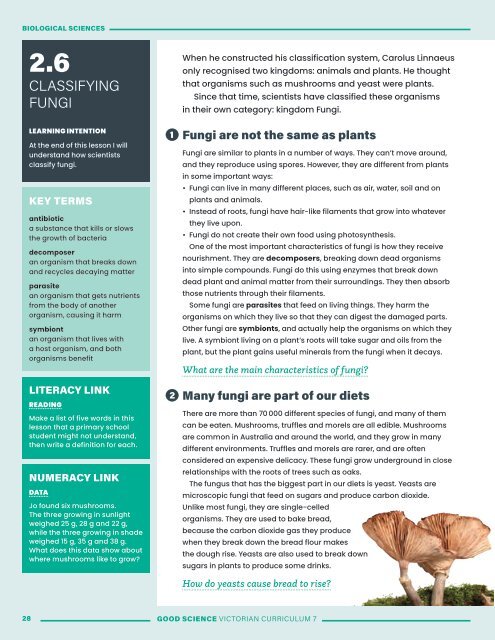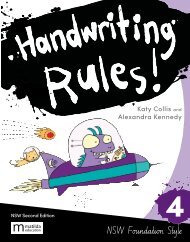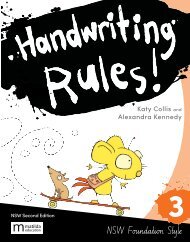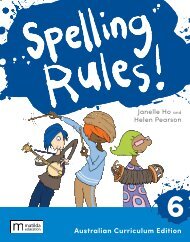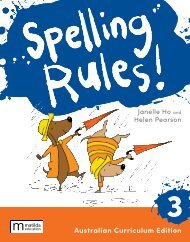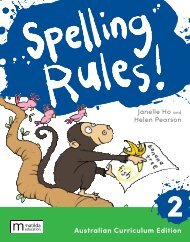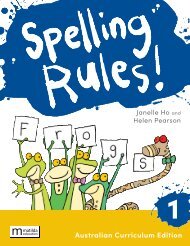Good Science Victorian Curriculum Year 7
Digital sample of Matilda's newest publication, Good Science Victorian Curriculum Year, authored by Emma Craven and Aaron Elias. For more information visit www.matildaeducation.com.au or email Katrina Tucker, katrinatucker@matildaed.com.au
Digital sample of Matilda's newest publication, Good Science Victorian Curriculum Year, authored by Emma Craven and Aaron Elias. For more information visit www.matildaeducation.com.au or email Katrina Tucker, katrinatucker@matildaed.com.au
You also want an ePaper? Increase the reach of your titles
YUMPU automatically turns print PDFs into web optimized ePapers that Google loves.
BIOLOGICAL SCIENCES<br />
2.6<br />
CLASSIFYING<br />
FUNGI<br />
LEARNING INTENTION<br />
At the end of this lesson I will<br />
understand how scientists<br />
classify fungi.<br />
KEY TERMS<br />
antibiotic<br />
a substance that kills or slows<br />
the growth of bacteria<br />
decomposer<br />
an organism that breaks down<br />
and recycles decaying matter<br />
parasite<br />
an organism that gets nutrients<br />
from the body of another<br />
organism, causing it harm<br />
symbiont<br />
an organism that lives with<br />
a host organism, and both<br />
organisms benefit<br />
LITERACY LINK<br />
READING<br />
Make a list of five words in this<br />
lesson that a primary school<br />
student might not understand,<br />
then write a definition for each.<br />
NUMERACY LINK<br />
DATA<br />
Jo found six mushrooms.<br />
The three growing in sunlight<br />
weighed 25 g, 28 g and 22 g,<br />
while the three growing in shade<br />
weighed 15 g, 35 g and 38 g.<br />
What does this data show about<br />
where mushrooms like to grow?<br />
1<br />
2<br />
When he constructed his classification system, Carolus Linnaeus<br />
only recognised two kingdoms: animals and plants. He thought<br />
that organisms such as mushrooms and yeast were plants.<br />
Since that time, scientists have classified these organisms<br />
in their own category: kingdom Fungi.<br />
Fungi are not the same as plants<br />
Fungi are similar to plants in a number of ways. They can’t move around,<br />
and they reproduce using spores. However, they are different from plants<br />
in some important ways:<br />
• Fungi can live in many different places, such as air, water, soil and on<br />
plants and animals.<br />
• Instead of roots, fungi have hair-like filaments that grow into whatever<br />
they live upon.<br />
• Fungi do not create their own food using photosynthesis.<br />
One of the most important characteristics of fungi is how they receive<br />
nourishment. They are decomposers, breaking down dead organisms<br />
into simple compounds. Fungi do this using enzymes that break down<br />
dead plant and animal matter from their surroundings. They then absorb<br />
those nutrients through their filaments.<br />
Some fungi are parasites that feed on living things. They harm the<br />
organisms on which they live so that they can digest the damaged parts.<br />
Other fungi are symbionts, and actually help the organisms on which they<br />
live. A symbiont living on a plant’s roots will take sugar and oils from the<br />
plant, but the plant gains useful minerals from the fungi when it decays.<br />
What are the main characteristics of fungi?<br />
Many fungi are part of our diets<br />
There are more than 70 000 different species of fungi, and many of them<br />
can be eaten. Mushrooms, truffles and morels are all edible. Mushrooms<br />
are common in Australia and around the world, and they grow in many<br />
different environments. Truffles and morels are rarer, and are often<br />
considered an expensive delicacy. These fungi grow underground in close<br />
relationships with the roots of trees such as oaks.<br />
The fungus that has the biggest part in our diets is yeast. Yeasts are<br />
microscopic fungi that feed on sugars and produce carbon dioxide.<br />
Unlike most fungi, they are single-celled<br />
organisms. They are used to bake bread,<br />
because the carbon dioxide gas they produce<br />
when they break down the bread flour makes<br />
the dough rise. Yeasts are also used to break down<br />
sugars in plants to produce some drinks.<br />
How do yeasts cause bread to rise?<br />
28 GOOD SCIENCE VICTORIAN CURRICULUM 7


